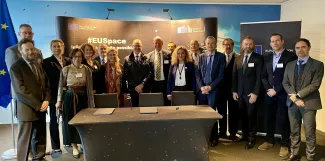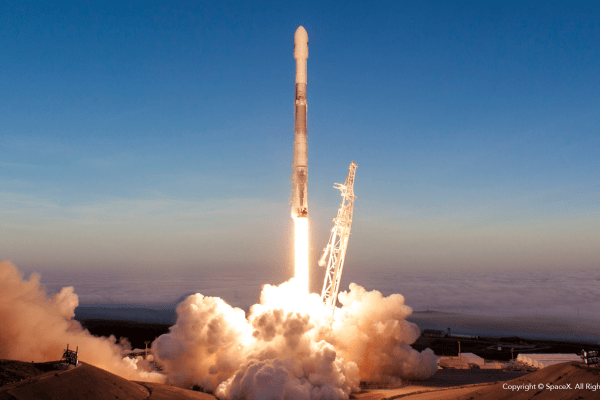New Copernicus Data Access Service kicked off
The next level of data processing and distribution infrastructure
We’re proud to announce that the new Copernicus Data Access Service has been successfully kicked off, taking the European Union Copernicus program to the next level and ensuring the data to make the greatest possible impact to institutional users, the research community, the commercial sector as well as to every citizen of our planet. The new Copernicus Data Access Service builds on existing distribution services and DIAS-es, ensuring their continuity, but it is also much more - it is bringing significant improvements. Powered by leading European cloud and earth observation service providers T-Systems, CloudFerro, Sinergise, VITO, DLR, ACRI-ST and RHEA we look forward to bring the EU Copernicus program to the next level.
The European Union Copernicus program is the biggest provider of Earth Observation data in the world and its launch was almost certainly one of the most important events in the remote sensing community over the past decade. With systematic monitoring over large areas, good quality of data, resolution fitting its objectives, ensured longevity of the program and, most importantly, clear and simple open data policy it took the world by a storm. This, however, is not something to be taken for granted. When Copernicus started, remote sensing was a niche field occupying mostly researchers and the intelligence community. There was no specific reason to expect that it will be any different with Sentinel data. The data has been picked up tremendously and no longer mainly by researchers. Public authorities, commercial companies, SME’s and even individual citizens saw the benefit of using EO data for various applications.
Copernicus must strive for digital excellence. We want Copernicus data to be easily accessible and usable. At the same time, we need a powerful data analytics environment to attract new user, in particular from non-space sectors.
Thierry Breton - Commissioner for Internal Market
Now, less than 10 years after the launch of the Copernicus programme, countless applications are using EO data to provide accurate, timely and objective information to support several businesses crucial to create a more sustainable future. From helping farmers to manage their fields over financial markets to forecast food prices to the EU Common Agriculture Policy to monitor sustainable agricultural practices. Every day we see more and more digital twins of our environment to better understand and mitigate the effects of climate change.
Copernicus is a tremendous validation of ESA's operational capacity, but at the same time also significant pressure on the data distribution systems. The Copernicus Data Hubs have already distributed an order of magnitude more data than are published. With user uptake growing rapidly, as well as recognized importance of Earth Observation data for the monitoring of the climate changes, the EU decided to invest in the next level of user data processing and distribution infrastructure. The new Copernicus Data Access Service is set up to further improve access and exploitation of the EU's Copernicus satellites data.
Easy discovery, visualisation, download, and analysis
The new Copernicus Data Access Service will be powered by experienced players - T-Systems and CloudFerro with their well-used cloud infrastructure, Sinergise and VITO with Sentinel Hub and OpenEO data discovery and processing tools, and DLR, Acri-ST and RHEA taking care for on-demand processing and Copernicus Contributing Missions. All of them are well versed in ESA-lead projects. Furthermore, the majority of the technology, which the service will be built upon, has been developed and validated within past ESA and Copernicus activities. The partners will work under close guidance of ESA in order to address objectives set by the European Commission.
The Copernicus Data Access Service will be the first environment to offer just about all the data ever acquired by Sentinel satellites including e.g. Sentinel-1 SLC and GRD and L2 OCN, Sentinel-2 L1C and L2A, Sentinel-3 and Sentinel-5P L1 and L2 data as well as Copernicus Contributing Missions data. The data will be available open and free through various interfaces – from old-fashioned download, direct S3 access with STAC items and cloud-optimized formats to streamlined access APIs, which are able not just to fetch the data but also process it. There will be a web-based application built on top of a very popular EO Browser technology, as well as a JupyterLab. And several on-demand processors capable of building non-default formats and derived products such as Sentinel-1 coherence and CARD4L products, MAJA-powered atmospheric processing and similar. For those interested in processing, there will be scalable cloud resources available, optimized for EO tasks. The Copernicus Data Access Service will also focus on traceability. With the nowadays advances in machine learning-powered image manipulation, it will be possible to trace the source of all the data managed within the Copernicus Data Access Service as well as what operations were performed.

A new service to benefit every citizen of our planet
Important for many of you – the vast majority of these capabilities will be available free for use, funded by the European Union. The quotas designated for users should more than suffice for the individual's use - personal, research or commercial. For those interested in larger scale operation, there will be practically unlimited resources available under commercial terms, powered by the industrial team partners and accessing the identical full set of data collections as well as additional open and commercial ones, allowing to build applications on world scale. Furthermore, there will be significant credits made available, in the form of extra free resources, to be used for research and pre-commercial exploitation opportunities.
The Copernicus Data Access Service has been kicked of 16 December 2022 and will start with an intensive phase-in period in order to allow hundreds of thousands of existing users of Copernicus Hubs to migrate their workflows to the new service. First, limited but stable, roll-out is planned for the end of January 2023 with continuous upgrades over the upcoming months until the full service will be made available by the end of June 2023.
This is a very challenging yet super exciting opportunity for everyone in the remote sensing community - from beginners to experts, from researchers, companies and institutions, as well as individuals. Just about anyone can benefit from being aware of what is happening with our planet. And we should all take interest in it, and act. For the consortium partners, however, this is especially important - we were given an opportunity to build a new ecosystem for everyone to use. An ecosystem that strives to provide a significant upgrade over existing tools and services. This comes with huge responsibility towards everyone - not just to the ESA and European Commission, but for the world-wide EO community.











